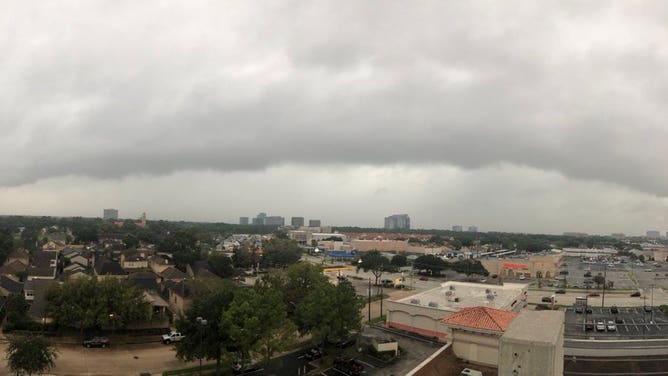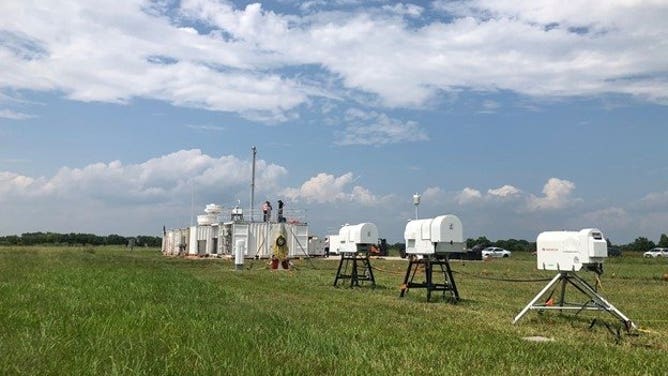Aerosol-cloud study could improve weather forecasting, climate models
Billions of tiny particles known as aerosols are created by natural events like sea salt, and wildfires but aerosols are also derived from gases created by humans. These tiny particles interact to help form clouds and can impact Earth’s climate.

A shelf cloud over Houston Wednesday, October 27, 2021, as a fast-moving storm brought the threat of tornadoes to the area. (Image credit: Paul Medica)
(FOX Weather)
By studying how tiny particles from pollutants impact cloud formation, a group of atmospheric chemists hopes to improve weather forecasting and long-term climate models.
University of Houston Associate Professor of Earth and Atmospheric Sciences Yunsoo Choi explains it's rare for cloud atmospheric chemists and climate scientists to collaborate. Still, a new study will use both fields of science to benefit climate research.
Billions of tiny particles known as aerosols are created by organic materials like sea salt, soil and wildfires. Aerosols are also derived from gases created by humans like soot, car exhaust and cattle farming.
"In the industrial area, they make a lot of nitrate and sulfate … from the industry and power plants today they emit a lot of CO2, sulfur dioxide, and then this gas will become sulfate," Choo offers as one example.
These tiny particles interact to help form clouds and can impact Earth’s climate.
6 TYPES OF CLOUDS YOU MIGHT SEE DURING SEVERE STORMS
Recent studies have shown aerosols can be associated with hailstorms, lightning and other severe weather events, but the amount of impact is still up for debate.
This summer University of Houston scientists took part in a Department of Energy’s Atmospheric Radiation Measurement (ARM) user facility study that looked at aerosols during Houston’s peak summer storm season.
During the TRACER study, short for TRacking Aerosol Convection interactions ExpeRiment, mobile ARM instruments were set up in Houston and surrounding areas from June to September to track cloud properties, the chemical composition of aerosols and rain.
The Department of Energy’s Office of Science recently awarded Choi and his graduate students, Arman Pouyaei and Ali Mousavinezhad, a $550,728 grant to continue studying aerosol-cloud impacts over the next three years.

Clouds over the Department of Energy Atmospheric Radiation Measurement (ARM) mobile user facility in La Porte, Texas, as researchers set up equipment for the TRacking Aerosol Convections interactions ExpeRiment (TRACER). (Image courtesy of DOE ARM)
By combining the TRACER Campaign data with chemistry modeling, Choi and his team believe they can better understand the aerosol-cloud interactions, specifically the impacts of particles on cloud thermodynamics, radiative properties and more.
Clouds are typically associated with a cooling effect because of the amount of solar radiation reflected back to space, but Choi said not all clouds have this same effect.
WATCH: DAZZLING WEATHER PHENOMENON THAT LIGHT UP THE SKIES IN EVERY COLOR OF THE RAINBOW
The wispy-thin cirrus clouds emit solar radiation back to the Earth’s surface.
"The cooling effect is more in terms of reflecting solar energy, but we need to do this kind of detailed science because (in) some areas we are going to have more cirrus cloud-types and other areas in Houston, we are going to have a more cumulus clouds," Choi said.
According to Choi's proposal, clouds with high concentrations of aerosols have more and smaller water droplets than clouds with the same water content in cleaner areas. The clouds with higher aerosol content have a higher albedo, or reflection of solar radiation back to Earth.
Different aerosols can also have a direct effect on Earth's radiation field depending on their physical properties, according to NASA. While some aerosols reflect light, others are more likely to absorb it.
That’s why it’s essential to better understand the structure of clouds and the aerosols that help clouds form to improve climate modeling.
HOW DO CLOUDS AFFECT THE CLIMATE ON EARTH?
Choi said the ultimate goal is to create a machine-learning modeling system that simulates the aerosol and cloud interaction in real-time to be used for daily weather forecasting and climate modeling.
According to Choi, this modeling system could benefit weather forecasting, including how precipitation changes, wind speed, predicting tornado frequency and even hail.
Understanding this relationship between organic and pollutant aerosols on clouds in the long term could help improve climate models. Choi said today’s climate models don’t factor in this type of aerosol-cloud interaction.
"By doing this kind of more detailed study about aerosol and cloud interaction, we can more accurately understand the cloud impact, or interaction, between a cloud and aerosol on climate," Choo said. "This is very important because the clouds cover 70% of the Earth's surface."